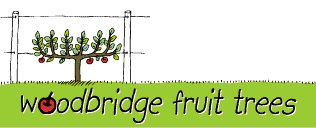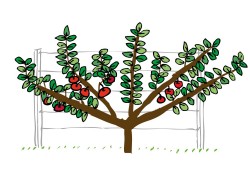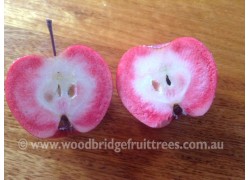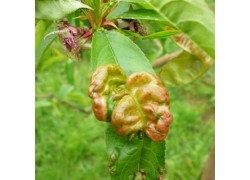No products
Filter
We have complied a selection of articles that we've written, that you'll find helpful.
Articles / Learning There are 27 products.
-
Apple Cross Pollination
From the amount of inquiries I receive about cross pollination I’m convinced that this is a very misunderstood part of apple culture. Apples have a very large and rich genetic background just as we humans have, and this has enabled them to adapt to and be grown in just about all climate zones
-
Receiving Your trees
When you receive your young trees, it’s a good idea to stand them in a bucket of water overnight. If you’re not ready to plant them you can 'heel them in' a temporary position for a week or two. Just bury the roots in a pile of moist sawdust or loose soil, and keep moist but not wet. At no stage allow the roots to dry out.
-
Espaliering Made Easy
Despite what the gardening media can imply, people who actually do produce their own food or part of it, know it is not a matter of skipping through the flower-dotted lawn to pick a perfect lettuce of a plump peach from a sweet little garden ringed with calendulas. The sweet little garden is more likely to be ringed with wire netting
-
Pruning - why we do it
Recently I had a Croatian chap ring me for some advice. He’d bought a Cox’s Orange and a Pine Golden Pippin from me a few years ago. They just had their first decent crop and he wanted to know what 'to do' with them now. I figured out that 'to do' was how to prune them and as our conversation continued I had to think of the whole
-
Constructing Trellises and Strainers
A trellis is a structure or framework upon which to train a plant. Ideally it needs to support itself, support the tree and offer some way of tying branches down so as to define the shape of an espalier system. The trellis system and size should reflect the growth habit of the tree or trees that it’s supporting. For example, a kiwi trellis needs to...
-
Potted Fruit Trees
Fruit trees really prefer to be planted in the ground, but in some situations it would be great to have them in pots. Although you wont get the yield or size of fruit, dwarfing fruit trees will do well either as a espalier or open tree in pots. They should be planted in winter, and best to buy them bare-rooted one year old trees.
-
Pruning - summer and winter
If nobody has any idea about cross pollination and the sexual habits of our fruit trees, just about everyone has an opinion - even people who’ve never got their hands dirty - about how to prune them. Now pruning is the process whereby we shape and train a young tree and prepare it for a life of producing fruit for us. Pruning is
-
Spanish bush pruning
The northern coast of Spain on the Bay of Biscay has a mild moist climate quite similar to southern Australia and Tasmania. Most of Spain’s dairies and apple orchards are here. There’s also a surprisingly large amount of eucalyptus trees (mostly E. Globulus). In the province of Asturias in the middle of the Atlantic coast are most
-
Dwarfing PearTrees
We grow pears in dwarfing forms for the same reasons we grow other types of dwarfed trees: small trees are much more precocious in starting to bear fruit in about their third year. This is very important as pears on normal pear stock live a very long time, grow into large trees and can take many years to come into fruit.
-
Espaliering Apricots and Plums
We continuously receive enquiries about the possibility of espaliering stone fruit i.e. apricots and plums, and my reply is that they are far too vigorous but there aren’t any satisfactory dwarfing root stocks available for apricots and plums as there are for apples and pears. To try and contain a 4 metre apricot tree at a 2 metres
-
Espaliering Made Even Easier - KNNN method
You may have noticed that there is a quiet revolution happening in gardening in Australia. It may have something to do with the environment and it may have something to do with the industrialisation of the way much of our food is produced. Many people are genuinely trying to produce some part of their own food in their own
-
Rootstocks explained
A rootstock is an simply a variety selected especially for it’s disease resistance, health and vigour. These characteristics are passed onto the whole tree once the desired variety is grafted on top. Rootstocks are usually grown in stool beds where they are layered down and the vertical shoots harvested along with a few roots
-
Woolly Aphid and Rootstocks
We have had enquiries lately about rootstocks resistant to woolly aphid and this article is in response to those enquiries. Woolly aphid is a very destructive insect pest that almost wiped out the apple industry here in Tasmania and in South Africa in the early 1900’s. Before the time of modern pesticides, orchardists were forced to use poisons based on...
-
What are dwarfing fruit trees? How to make...
The Greek historian Theophrastus writing in about 350 BC recorded that Alexander the great sent home to Greece from Asia minor plant material of the 'Spring apple', a dwarf, self rooting form of malus. This message from almost 2500 years ago is the first reference to what became known as the paradise apple. From the many subsequent
-
Step-over Apples
What are step-overs? It’s not a very gracious name for an extremely dwarf apple plant that is grown typically as a fruitful hedge or border to an ornamental vegetable garden, a potager garden. Their success is totally dependant on growing them on an extremely dwarfing rootstock. If this tree is left to grow to it’s full size it may
-
Rabbits and Apple Trees
It seems rabbits (and sometimes hares) have a definite taste for apple trees - often particularly newly planted ones during winter. We’re regularly receiving calls from people (gardeners) who have gone out one morning to find their trees stripped of bark up to a height of 30cm (rabbit height) - so watch out! The best way to avoid this
-
Pruning - the grape story
The grape vine is probably the plant most dependent on rigorous and hard pruning to maintain it in a vigorous cropping cycle. Have you ever seen an abandoned vineyard? It’s not very nice. In order to produce grapes we resort to very 'un - natural' techniques. If left to their own device grapes being natural climbers weave their way
-
Price Differential in Apples or How the...
Humans have long ago worked out how to produce apples very efficiently. So much so that we can produce as many apples per hectare as potatoes – and we reached that curious point where you can buy apples even cheaper than potatoes.... Orchardists are leaving the industry in large numbers and the agricultural department keeps telling th
-
Growing Hazelnuts
The Hazel is an unusual and interesting plant. There are hazel varieties native to all the temperate zones of the northern hemisphere - North America, Europe, Turnkey, China and even the Himalayas but only one (the European hazel) is cultivated for its edible nuts. It appears (from pollen counts in peat bogs) that the hazel was
-
Growing Raspberries
We grow pears in dwarfing forms for the same reasons we grow other types of dwarfed trees: small trees are much more precocious in starting to bear fruit in about their third year. This is very important as pears on normal pear stock live a very long time, grow into large trees and can take many years to come into fruit.
-
The story of Magnus Summer Surprise
If nobody has any idea about cross pollination and the sexual habits of our fruit trees, just about everyone has an opinion - even people who’ve never got their hands dirty - about how to prune them. Now pruning is the process whereby we shape and train a young tree and prepare it for a life of producing fruit for us. Pruning is
-
Leaf Curl
From the amount of inquiries I receive about cross pollination I’m convinced that this is a very misunderstood part of apple culture. Apples have a very large and rich genetic background just as we humans have, and this has enabled them to adapt to and be grown in just about all climate zones
-
Codling Moth Control
Colding Moth Control This is a troublesome worm that can affect apples, pears and quinces. The adult moth is 10-15mm long, and tiny pin head eggs are laid in September and hatch into caterpillars after 10 days where it feeds on leaves before moving onto fruit. It feasts on the fruit for 3-5 weeks to fatten up, after which it leaves the fruit looking for...
-
Duo Planting
by Nik Magnus | © 2022 Woodbridge Fruit Trees | www.woodbridgefruittrees.com.au A tree with two or three varieties grafted onto it usually has the problem where one variety commands more energy from the plant and dominates. Unless carefully pruned, the less dominant grafts get taken over by the more vigorous variety. One solution that allows for two...
-
Cherry Slug
Cherry Slug is a troublesome pest that eats the leaves of cherry, pear, quince, plum, medlar and hawthorn trees. Its the larvae of the sawfly wasp, which lays its eggs on the leaves in October - November which munch on the leaves. They can skeletonise the leaves on these trees within weeks and stop the tree from making any more food or leaves for the...




























